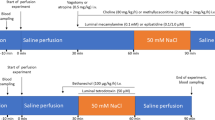Abstract
The effects of the 5-HT4 receptor agonists BIMU 8, BIMU 1, renzapride and of the 5-HT1p receptor agonist 5-hydroxyindalpine on basal and electrically evoked outflow of tritium were studied in guinea-pig longitudinal muscle myenteric plexus preparations preincubated with [3H]choline. Muscle contractions were recorded simultaneously.
BIMU 8 caused a calcium dependent and tetrodotoxin sensitive increase in basal [3H]outflow that was assumed to represent release of [3H]acetylcholine. In addition, BIMU 8 enhanced the release of [3H]acetylcholine and twitch contractions evoked by submaximal electrical stimulation. Ondansetron (1 μmol/l) did not change the effects of BIMU 8, but DAU 6285 and tropisetron (each 1 μmol/l) competitively antagonized the various facilitatory effects of BIMU 8 with pA2 values of 7.0–7.2 (DAU 6285) and 7.0–7.3 (tropisetron). The phosphodiesterase inhibitors IBMX and rolipram did not increase the effects of BIMU 8. BIMU 1 and renzapride also concentration-dependently increased basal release of acetylcholine, and release and contractions caused by submaximal stimulation. The effects of BIMU 1 and renzapride were competitively antagonized by 1 μmol/l tropisetron (pA2 6.6–7.1). The EC50 values for the increase in the evoked [3H]acetylcholine release and contractions were closely similar. 5-Hydroxyindalpine did not change basal release and slightly inhibited the evoked release of [3H]acetylcholine. Release of acetylcholine and contractions elicited by submaximal stimulation were strongly inhibited by ( + )-tubocurarine which indicates that nicotinic ganglionic transmission is involved in this kind of release.
The results suggest that BIMU 8, BIMU 1 and renzapride stimulate 5-HT4 receptors at cholinergic interneurones and thereby facilitate nicotinic ganglionic transmission in the myenteric plexus. Cyclic AMP is probably not involved in the 5-HT4 receptor mediated facilitation of acetylcholine release.
Similar content being viewed by others
References
Baxter GS, Clarke DE (1992) Benzimidazolone derivatives act as 5-HT4 receptor ligands in rat oesophagus. Eur J Pharmacol 212:225–229
Baxter GS, Craig DA, Clarke DE (1991) 5-Hydroxytryptamine4 receptors mediate relaxation of the rat oesophageal tunica muscularis mucosae. Naunyn-Schmiedeberg's Arch Pharmacol 343:439–446
Beavo JA, Reifsnyder DH (1990) Primary sequence of cyclic nucleotide phosphodiesterase isozymes and the design of selective inhibitors. Trends Pharmacol Sci 11:150–155
Consolo S, Arnaboldi S, Giorgi S, Russi G, Ladinsky H (1994) 5-HT4 receptor stimulation facilitates acetylcholine release in frontal cortex. Neuroreport 5:1230–1233
Craig DA, Clarke DE (1990) Pharmacological characterization of a neuronal receptor for 5-hydroxytryptamine in guinea pig ileum with properties similar to the 5-hydroxytryptamine4 receptor. J Pharmacol Exp Ther 252:1378–1386
Dumuis A, Bouhelal R, Sebben M, Cory R, Bockaert J (1988) A nonclassical 5-hydroxytryptamine receptor positively coupled with adenylate cyclclase in the central nervous system. Mol Pharmacol 34: 880–887
Author information
Authors and Affiliations
Rights and permissions
About this article
Cite this article
Kilbinger, H., Gebauer, A., Haas, J. et al. Benzimidazolones and renzapride facilitate acetylcholine release from guinea-pig myenteric plexus via 5-HT4 receptors. Naunyn-Schmiedeberg's Arch Pharmacol 351, 229–236 (1995). https://doi.org/10.1007/BF00233241
Received:
Accepted:
Issue Date:
DOI: https://doi.org/10.1007/BF00233241




